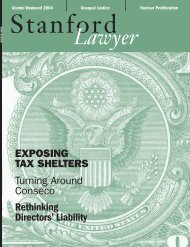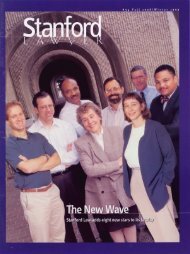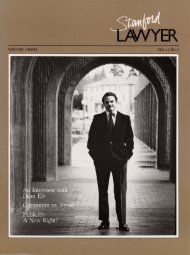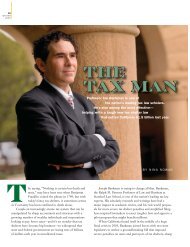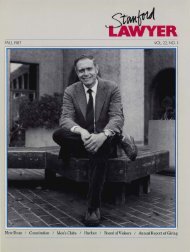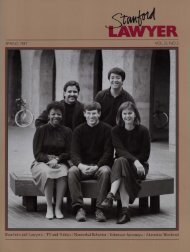Issue 73 - Stanford Lawyer - Stanford University
Issue 73 - Stanford Lawyer - Stanford University
Issue 73 - Stanford Lawyer - Stanford University
You also want an ePaper? Increase the reach of your titles
YUMPU automatically turns print PDFs into web optimized ePapers that Google loves.
DISCOVERY<br />
39<br />
STANFORD<br />
LAWYER<br />
duce collateral social benefits.<br />
Nonetheless, the analogy has problems. The<br />
fundamental differences between intellectual<br />
property rights and other forms of government<br />
subsidy have to do with how the recipients of<br />
that subsidy are selected and the size of the subsidy<br />
determined. While with most government<br />
subsidies the government makes both choices, in<br />
the case of intellectual property the government<br />
leaves those decisions to the very market it is<br />
attempting to influence. Because many criticisms<br />
of government subsidies focus on size and allocation,<br />
they may not apply to intellectual property.<br />
A related formulation is intellectual property<br />
as government regulation. Intellectual property<br />
is obviously government regulation in the classic<br />
neutral sense of that term—government<br />
intervention in the free market to alter the outcome<br />
it would otherwise produce because of a<br />
perceived market failure. Further, copyright in<br />
particular (and, to a lesser extent, patent) have<br />
become increasingly regulatory in structure, with<br />
statutes setting out detailed rules, regulations,<br />
and prices for specific uses in specific industries.<br />
Nonetheless, there are some problems with the<br />
subsidy and regulation analogies. Drawing the<br />
analogy to welfare may have a problem similar<br />
to the problem with the property story: it brings<br />
with it too much baggage.<br />
None of these analogies is even close to perfect.<br />
If there are sufficient dissimilarities between<br />
intellectual property and other areas of law, drawing<br />
analogies becomes problematic, not only<br />
because of the caveats that are required (“intellectual<br />
property is like any other tort, except in the<br />
following ways”), but because those caveats have<br />
a way of getting lost over time. This may be what<br />
has happened with efforts to talk about intellectual<br />
property as a form of property: over time, it<br />
is too easy to rely on the shorthand reference to<br />
property and to come to believe that intellectual<br />
property really is like other kinds of property.<br />
In the final analysis, I don’t know that we<br />
need an analogy at all. We have a well-developed<br />
body of intellectual property law, and a large and<br />
developing body of economic scholarship devoted<br />
specifically to intellectual property. The needs<br />
and characteristics of intellectual property are<br />
unique, and so are the laws that establish intellectual<br />
property rights. As the supreme court of<br />
Canada recognized 25 years ago, copyright law is<br />
neither tort law nor property law in classification,<br />
but is statutory law. It neither cuts across existing<br />
rights in property or conduct nor falls between<br />
rights and obligations heretofore existing in the<br />
common law. Copyright legislation simply creates<br />
rights and obligations upon the terms and in the<br />
circumstances set out in the statute.<br />
Intellectual property has come of age; it no<br />
longer needs to turn to some broader area of<br />
legal theory to seek legitimacy. The economics<br />
of intellectual property law should focus on the<br />
economic characteristics of intellectual property<br />
rights, not on inapposite economic analysis borrowed<br />
from the very different case of land.<br />
If we don’t need an analogy, maybe we need<br />
a new term. If people think of intellectual property<br />
as a form of property because of its name,<br />
then the name should probably go. But it has<br />
built up considerable inertia, and it does capture<br />
some of the similarities between the different<br />
fields it unites. Furthermore, none of the dozens<br />
of alternatives people have suggested seem likely<br />
to replace “intellectual property” in the public<br />
lexicon. So here’s a modest suggestion: instead<br />
of intellectual property, let’s start talking about<br />
“IP.” Lots of people already use it as a shorthand<br />
anyway. And if we are so unhistorical that the use<br />
of the term “intellectual property” can make us<br />
forget the utilitarian roots of our protection for<br />
inventions and creations, perhaps over time we<br />
can forget the origins of the abbreviation, too. ■<br />
This is an abridged version of an article published in Texas<br />
Law Review, March 2005.<br />
UNITED STATES PATENT OFFICE DEPARTMENT, WASHINGTON, D.C. IMAGE: © CORBIS





